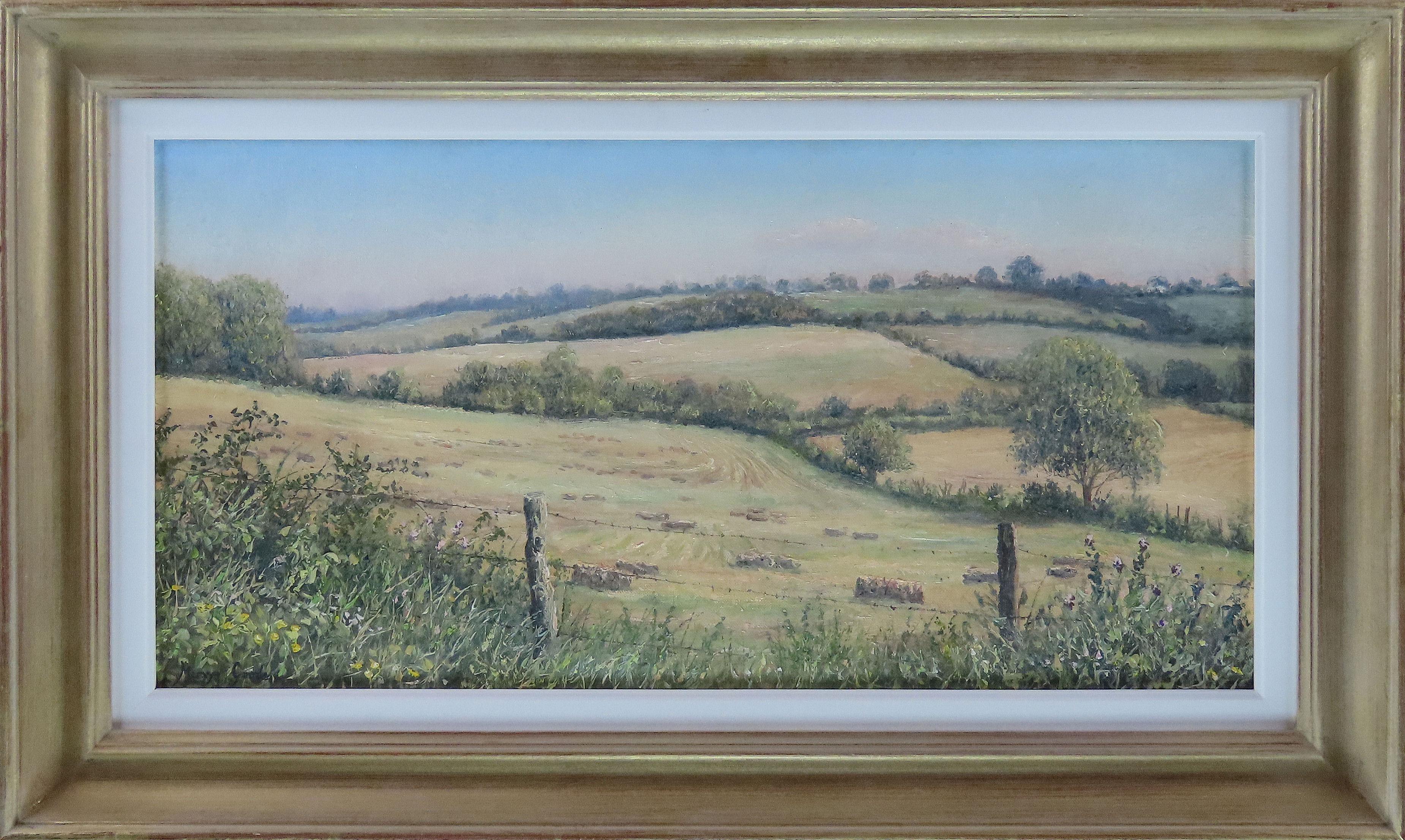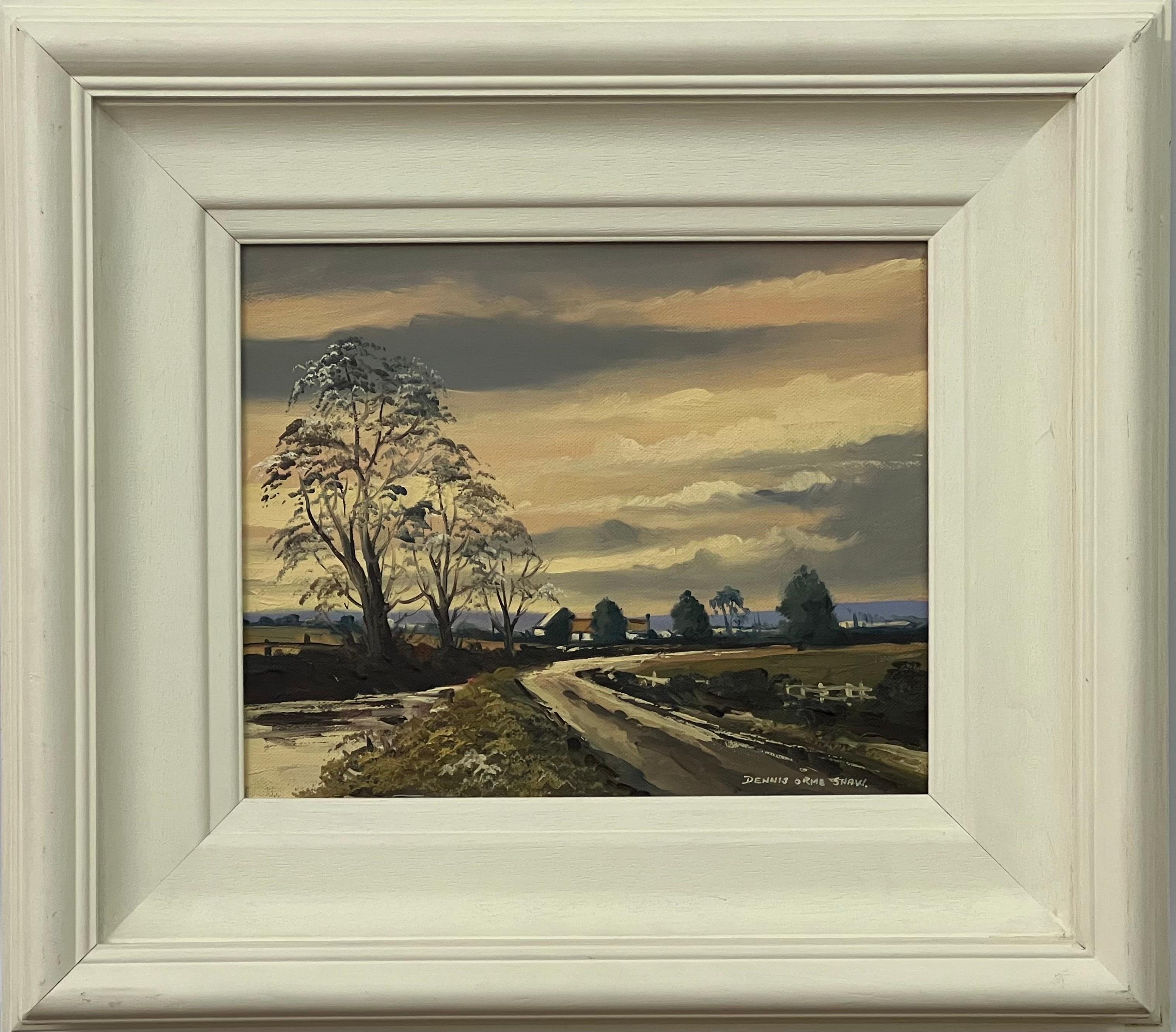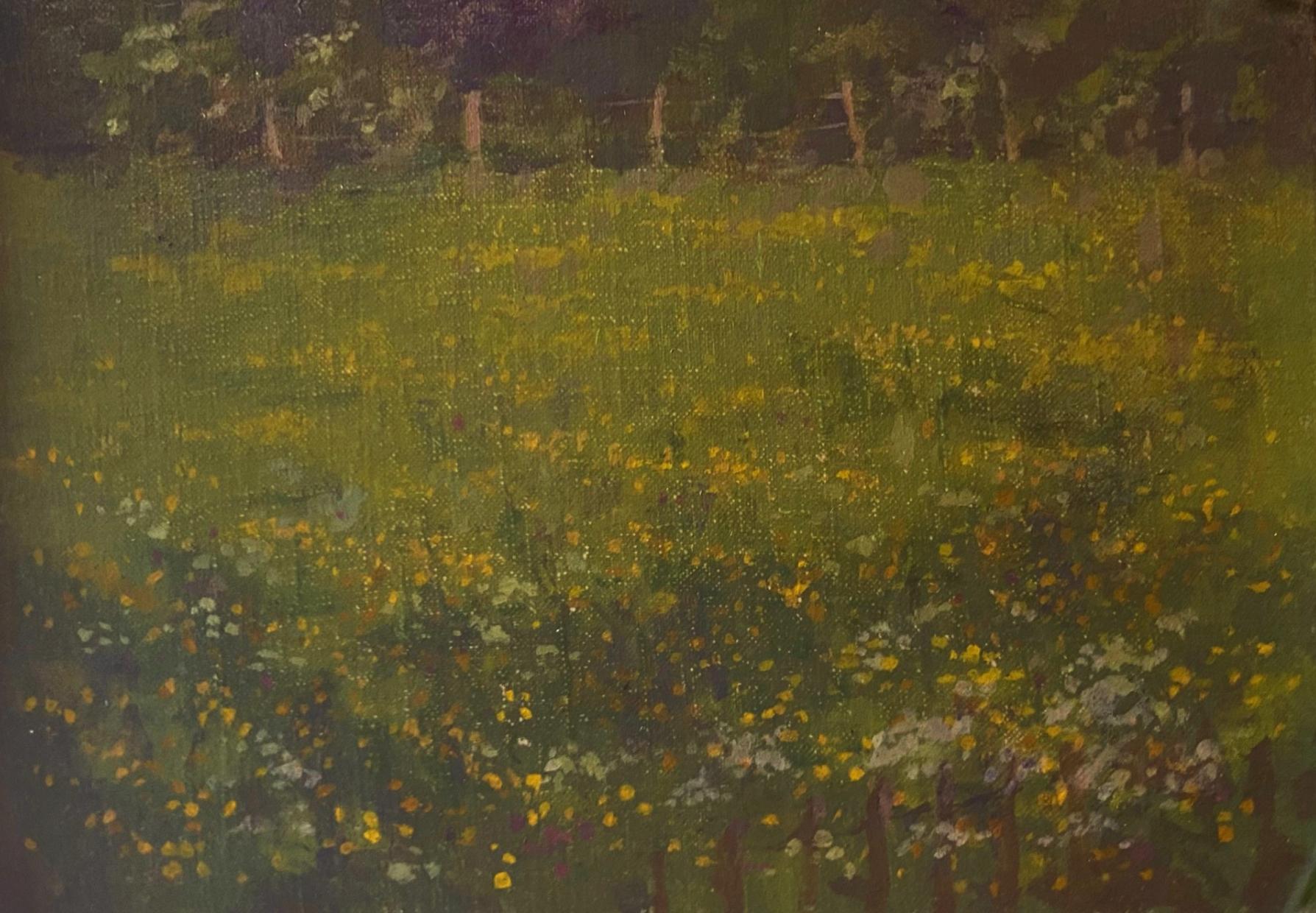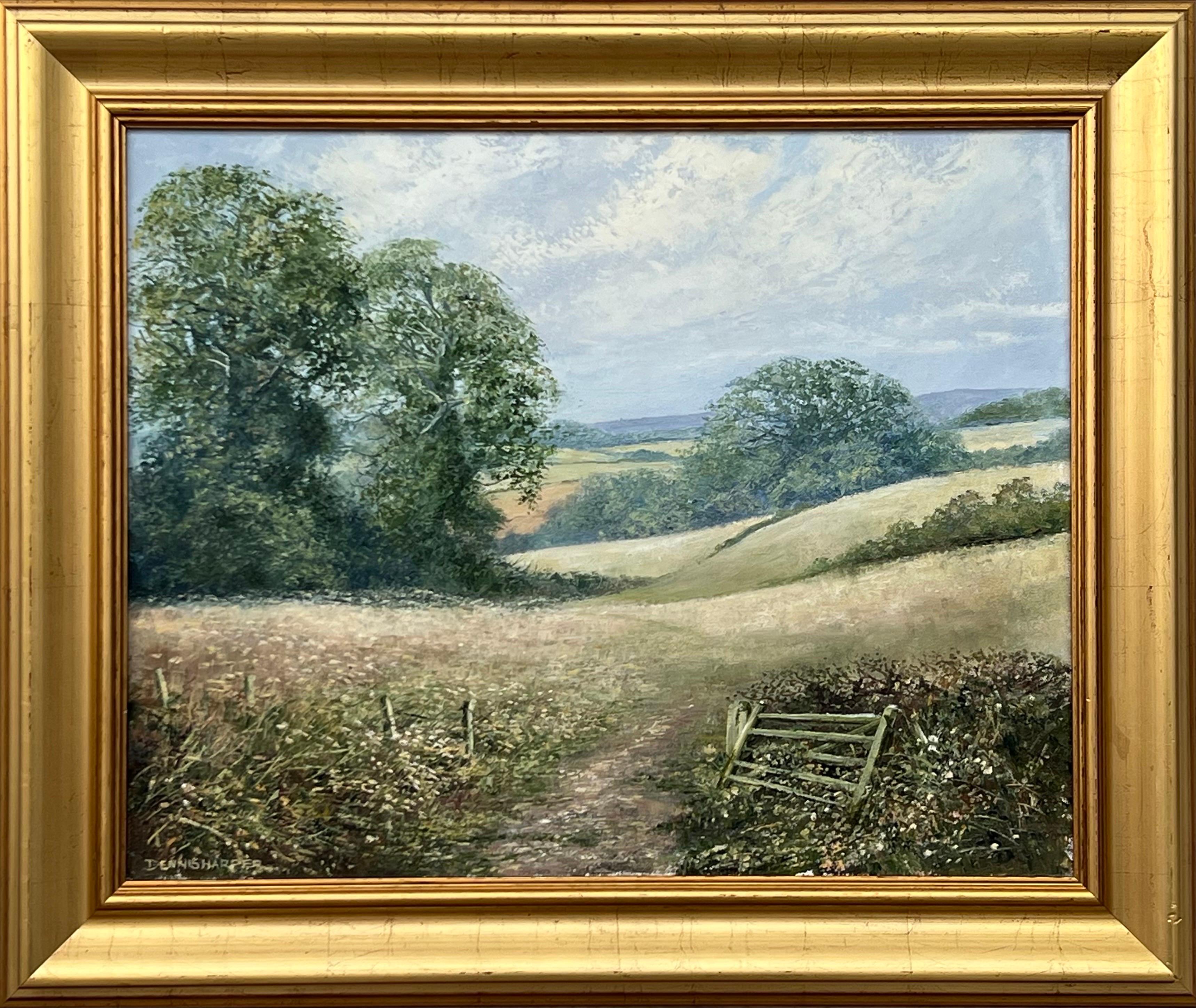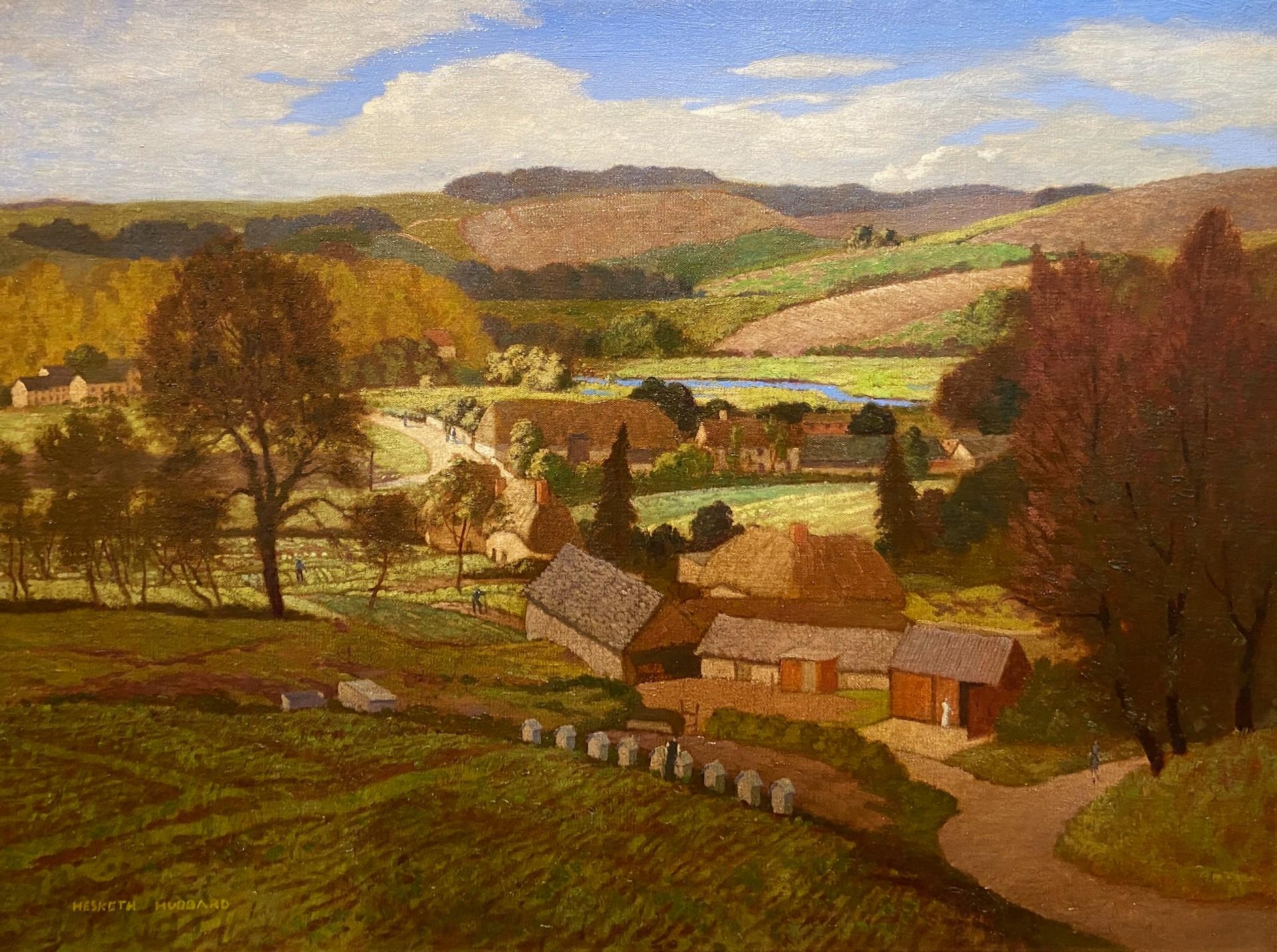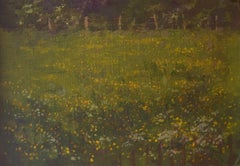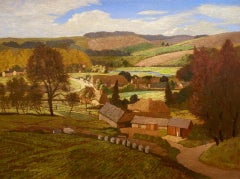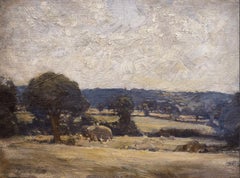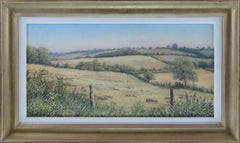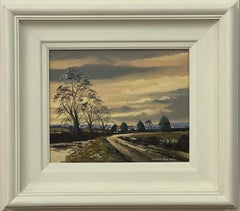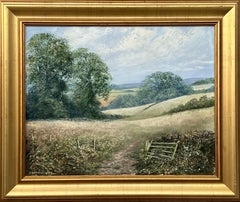Items Similar to Evening Landscape in Late May, 1970s Yorkshire Landscape, Oil on Board, Signed
Want more images or videos?
Request additional images or videos from the seller
1 of 7
Raymond BoothEvening Landscape in Late May, 1970s Yorkshire Landscape, Oil on Board, Signed1974
1974
$14,272.03
£10,400
€12,228.22
CA$19,705.75
A$21,852.22
CHF 11,481.72
MX$266,996.96
NOK 143,651.97
SEK 134,841.92
DKK 91,286.04
About the Item
Oil on board, signed and dated '1974' lower right
Image size: 31 x 48 inches (79 x 122 cm)
June 1987 Exhibition label on verso
Original frame
Provenance
The Artist's Estate
Exhibited
"Raymond Booth, A Memorial Exhibition", The Fine Art Society, London, 12th August - 9th September 2016, no.62
"Raymond Booth, In the Wild", The Fine Art Society, London, 02 May -29 May 2017, No. 11
Booth was above all a great recorder of the natural world who could translate his observations of the Yorkshire countryside, its fauna and flora, into compositions of a beauty and intensity rivalling the greatest of his Victorian predecessors.
This intense, yet intimate, landscape depicts a section of woods around Booth's home in Alwoodley, Leeds, where he spent much of his time. Here Booth has worked slowly to develop the densely worked, close-up, landscape in which the woodland and meadows have acquired a poetic quality through his sensitivity to season, weather and time of day.
Raymond Charles Booth
Intensely private, and possessing an obsessive work ethic and passion for the natural world, Raymond Booth earned a reputation as one of the greatest botanical painters and illustrators, despite rarely leaving his Yorkshire home. Eschewing the more fashionable modernist principles of the early mid-twentieth century, he instead produced beautiful, intense compositions in oil of British flora and fauna, that rival the very finest Victorian followers of the genre.
Raymond Booth was born in Wetherby, West Yorkshire, on 8 August 1929, to John Booth, a member of the local police force, and his wife Margaret Edna. When Raymond was still a young child, the family moved from their first home in the crowded streets of central Leeds, to Fearnville Place, in the leafy suburb of Roundhay. His father was a keen rambler and impressed upon Booth from an early age a respect and understanding for the British countryside. Just a short walk from his childhood home was Roundhay Park, the second largest urban park in Europe, comprised of over 700 acres of parkland, lakes and woodland. It is likely that growing up so close to such an environment had a profound influence on him, helping to develop what would become a lifelong obsession with natural world. Booth’s early passion for nature was surely heightened by the number of summer holidays he spent on an estate near Winterslow, Wiltshire, where an uncle worked as a gamekeeper.
In 1946, at the age of 17, Booth won a scholarship to study at Leeds College of Art. However, his studies were put on hold during two years of National Service, which he spent largely with the RAF in Egypt, guarding the Suez Canal. He returned to Leeds College in 1949, graduating in 1953. While at Leeds College, he had frustrated his teachers and fellow students by insisting on working in a more traditional, precise style, and rejecting the more Modernist principles that were being promoted. As a result, his teachers convinced him that he was unlikely to earn a living as an artist, and encouraged him instead to study for a teaching diploma. Shortly after graduation however, he was diagnosed as suffering from tuberculosis, a consequence of his time in Egypt, and was admitted to a sanatorium, where he would stay for the next six months. Years later, Booth would joke ‘I am one of the few people who can say, “Thank God for TB”’ (The Times obituary, 9 September 2015), as his months of recuperation gave him countless hours to develop his skills as a botanical artist. This enforced focus on his work gave him the confidence to submit a number of his drawings to a botanical art exhibition in London organised by the Royal Horticultural Society. These works attracted the attention of a number of prominent horticulturalists, including Dr Harold Fletcher, the director of the RHS’s gardens at Wisley, Sir George Taylor, director of the Royal Botanic Gardens at Kew, and the second Lord Fairhaven, all of whom would become patrons of Booth. His drawings at the Royal Horticultural Society also earned him a commission to illustrate a large two-volume work devoted to camellias, entitled The Camellia (1956), by Beryl Leslie Urquhart. When the actor Ernest Thesiger viewed the works at the RHS, he recommended them to the director of Walker’s Galleries on New Bond Street. As a result, Booth would exhibit there until its closure in 1961.
Following the closure of Walker’s Galleries, Booth began exhibiting, from 1962, at the Fine Art Society. He held is first solo show there in 1975, and would go on to have a further seven dedicated exhibitions, including a large, 50-year retrospective in 2011. Though he lent several owl studies to an exhibition on birds of prey at Leeds City Museum during the early 1970s, he remained virtually unknown in his native Yorkshire until a retrospective exhibition of his work toured his home county, going on display at Huddersfield Art Gallery, Crescent Art Gallery, Scarborough, and Cooper Gallery, Barnsley. In 1992, he completed one of his most ambitious undertakings, a collection of 85 drawings of Japanese flora for Don Elick’s Japonica Magnifica. This impressive publication was borne out of 12 years of correspondence between Booth and Elick, an American plant collector who had lived in Japan for over 40 years. During this time, Elick would send rare and exotic Japanese plants to Booth, who would grow them in his garden. His drawings for Japonica Magnifica were exhibited at the Fine Art Society and Lotherton Hall, Leeds, in 1992, and the Royal Botanic Garden, Edinburgh (1994), before spending two years touring the USA, going on display at the Paine Webber Gallery (New York) The Morris Museum (Morristown, New Jersey), the Elveheim Museum of Art (Madison, Wisconsin), the Hunt Institute for Botanical Documentation (Pittsburgh, Pennsylvania), Bruce Museum (Greenwich, Connecticut) and Chicago Botanic Garden.
Booth was an intensely private, almost reclusive artist who spent his career obsessively dedicated to his craft, rarely venturing from his home in Alwoodley, a suburb of Leeds. His exquisitely detailed and scientifically accurate oils were produced in a home studio from plant specimens that he personally cultivated in his garden and greenhouses, or from animal specimens that had been sent to him, such as foxes, badgers and birds, which he kept in a special refrigerator. Indeed, his first contact with Leeds City Museum was through the natural science collections, where the curators would lend him owls and rabbits for his studies. Despite an association of over fifty years, he visited the Fine Art Society only once. He did not personally appear at an opening of any of his shows until the major retrospective of his work held at Leeds Art Gallery in 2002.
Raymond Booth met his wife, Jean (née Wilson), the widow of the artist Ronald Pawson, at Gadsby’s artists’ materials shop, where she worked, close to his home. They were friends for many years before marrying in 1991. They lived together at 22 Far Moss, Alwoodley, Leeds, until Booth died from cancer on 26 June 2015. They had no children. The following year, a major memorial exhibition was held at the Fine Art Society.
His work is held in numerous public collections, including the Shirley Sherwood Gallery at Kew; The Fitzwilliam Museum (Cambridge) and Leeds Art Gallery; The Ulster Museum (Belfast) and the Hunt Institute for Botanical Documentation (Pittsburgh, PA)
About the Seller
5.0
Vetted Professional Seller
Every seller passes strict standards for authenticity and reliability
Established in 2007
1stDibs seller since 2014
82 sales on 1stDibs
Typical response time: 3 hours
- ShippingRetrieving quote...Shipping from: London, United Kingdom
- Return Policy
Authenticity Guarantee
In the unlikely event there’s an issue with an item’s authenticity, contact us within 1 year for a full refund. DetailsMoney-Back Guarantee
If your item is not as described, is damaged in transit, or does not arrive, contact us within 7 days for a full refund. Details24-Hour Cancellation
You have a 24-hour grace period in which to reconsider your purchase, with no questions asked.Vetted Professional Sellers
Our world-class sellers must adhere to strict standards for service and quality, maintaining the integrity of our listings.Price-Match Guarantee
If you find that a seller listed the same item for a lower price elsewhere, we’ll match it.Trusted Global Delivery
Our best-in-class carrier network provides specialized shipping options worldwide, including custom delivery.More From This Seller
View AllSummer, 20th Century British Landscape, Framed
Located in London, GB
Oil on board
Image size: 6 x 8 1/2 inches (15 x 21.5 cm)
Contemporary hand made float frame
We have a considerable collection of Benham's landscape works.
Please get in contact if ...
Category
Mid-20th Century Modern Landscape Paintings
Materials
Oil, Board
Hampshire Landscape 20th Century Oil Original Railway Artwork
By Eric Hesketh Hubbard
Located in London, GB
Eric Hesketh Hubbard
1892 - 1957
Hampshire Landscape
Oil on canvas, signed bottom left
Image size: 24 x 18 inches (61 x 46 cm)
Contemporary style hand made frame
This painting was c...
Category
20th Century Landscape Paintings
Materials
Canvas, Oil
Spring in Dorset, 20th Century English Oil Landscape, Female Artist
Located in London, GB
Oil on board
Image size: 12 1/2 x 15 1/2 inches (31.75 x 40 cm)
Contemporary style handmade frame
Exhibitions
1952 Royal Academy of Arts Exhibition, Gallery no. VII, no.429.
This forest scene invites the viewer into a multi-sensory event where the cool, damp shadows of the foliage can almost be felt and the rich bouquet of the forest floor recalled. Here, Sherlock has chosen a somewhat unusual angle and composition, dissecting each truck and tree form so that only a part can be seen. Furthermore, as we look into the depths of this space it becomes clear that we are stood gazing down into a valley that is in the distance, behind this wooded area. Indeed, instead of giving us an uninterrupted view of this vista, as perhaps would be expected, this view is deliberately blocked and our focus is directed instead towards the organic forms in the foreground.
The Artist
Marjorie Sherlock was born at Fir Tree Cottage, George Lane, Wanstead, Essex, on 3 February 1891, the elder child of the civil engineer, Henry Sherlock, and his wife, Alice (née Platts), who was born in Benares, India. By 1901, the family was living at ‘The Limes’, 121 Mill Road, Cambridge, and Marjorie received an education locally. In 1918, she entered into marriage with her cousin, Major Wilfrid Barrett, though this proved unsuccessful and they later divorced (he remarrying in 1941). She then continued to live at the family home until the Second World War.
During the First World War, Marjorie Sherlock studied at Westminster Technical Institute under the Camden Town School painters, Walter Sickert and Harold Gilman.
She exhibited at the Royal Academy of Arts from 1917, when she showed a powerful view of the interior of Liverpool Street Station (Government Art Collection) (to which the current etching [202] relates). In time, she would exhibit at the International Society, the New English Art Club, the Royal Society of British Artists, the Society of 207 Graphic Art and the Women’s International Art Club (becoming a member of the last two). She also showed work internationally.
Developing as a printmaker as well as a painter, Sherlock studied etching under Malcolm Osborne at the Royal College of Art in 1925. She published her etchings in four series, the titles of which indicate her love of travel: ‘English Etchings, ‘Egyptian Etchings’ (both 1925), ‘German Etchings’ (1929) and ‘Indian Etchings’ (1932). During this period, she also visited the united States. More admiring of Continental painters than British ones, she furthered her studies, in 1938, by working in Paris under André L’Hôte and André Dunoyer de Segonzac.
During the Second World War, Sherlock moved to East Devon and settled at Oxenways, a Victorian hunting lodge...
Category
1950s Modern Landscape Paintings
Materials
Canvas, Oil
Harvest Time, Oil on Canvas, 20th Century Signed British Landscape
By Septimus Edwin Scott
Located in London, GB
Oil on canvas on board, signed lower left
Image size: 10 1/2 x 14 inches
In the course of a long and varied career, Sep Scott exhibited in the Royal Academy and was a member of the Royal Watercolour Society.
Scott produced some famous works for the railway poster campaigns in his early years.
He became a book illustrator and one of the highest paid and respected of all British poster artists. Towards the end of his life, during a period when his style had gone somewhat out of vogue, he began working for Leonard Matthews and his trio of comics, Knockout, Sun and Thriller Comics Library.
At first, Scott was used for picture strips, drawing all the adventures of the pirate hunter, Captain Flame, and proving to be a natural born strip artist. Then, when Matthews took over Thriller Comics Library, Scott began to paint the covers. He drew scores of full colour cover paintings, which would, as Leonard Matthews commented, “grace the walls of any stately home”, and were, in all probability, largely responsible for the success of the Library and the fact that these comics are so valued today amongst collectors.
Scott also drew a number of short Robin Hood strips for the Library and some fine full-length adventure picture stories including Jane Eyre, Pride of the Ring, Secret Operator and the splendidly atmospheric, The Dark Shadows of London. For a short period, he also painted the occasional cover - and back page - for Comet and Sun and also contributed some paintings for the first Buck Jones Annual and the covers for both issues of the Billy the Kid Book...
Category
Early 20th Century Modern Landscape Paintings
Materials
Canvas, Oil, Board
The Standing Stone Wall, 20th Century English Signed, Oil Landscape
Located in London, GB
Oil on canvas, signed and dated '1948' bottom right
Image size: 10 3/4 x 16 1/2 inches (27.25 x 42 cm)
Contemporary style hand made frame
The Artist
Hugh Griffiths was a painter who was born in Karachi. Was educated at Canford School and the Dragon School, Oxford. Showed at RA, RBA and NEAC. Griffiths lived at Winchelsea and later St Leonards...
Category
Mid-20th Century Modern Landscape Paintings
Materials
Canvas, Oil
Salisbury Lanes, 20th Century English Landscape
By Eric Brown
Located in London, GB
ERIC BROWN
1894 - 1955
Salisbury Lanes
Oil on board, signed lower left
Image size: 7 x 10 inches
Contemporary frame
Eric Pitt Brown was born in 1894 in Sal...
Category
20th Century Landscape Paintings
Materials
Oil, Board
You May Also Like
Original Oil on Canvas, MERVYN GOODE, "Midsummer Landscape at Priors Dean"
By Mervyn Goode
Located in Mere, GB
MERVYN GOODE, born 1948
Studied Gloucestershire College of Art and never looked back after his first sell-out one-man exhibition in London in 1970. His work is regularly reproduced b...
Category
Late 20th Century Landscape Paintings
Materials
Oil
Sunset in Ireland Countryside - Original Oil Painting by Northern Irish Artist
Located in Preston, GB
Sunset in Ireland Countryside - Original Oil Painting by Northern Irish Artist, Dennis Orme Shaw
Art measures 10 x 8 inches
Frame measures 16 x 14 inches
Dennis Orme Shaw was bo...
Category
20th Century Modern Landscape Paintings
Materials
Canvas, Oil
Rural Field Landscape Oil Painting of an Idyllic English Countryside Scene
Located in Preston, GB
Rural Field Landscape Oil Painting of an Idyllic English Countryside Scene, by British Artist Dennis Harper, ( b. 1940)
Harper is best known for his Rea...
Category
Late 20th Century Realist Landscape Paintings
Materials
Canvas, Oil
Hubert Hennes (b.1907) - Mid 20th Century Oil, A Country Walk
By Hubert Hennes
Located in Corsham, GB
A wonderful study of a young woman walking amongst the overgrowth of the English countryside. Signed. On canvas on stretchers.
Category
20th Century Landscape Paintings
Materials
Oil
$393 Sale Price
20% Off
View from the Road Between Cambo and Hexham - 20th C Landscape Oil Painting
By Peter Greenham
Located in Kingsclere, GB
Peter Greenham was a distinguished figurative painter of portraits, landscapes and incidents from domestic life. His work was both sensitive and intelligent and like himself, without...
Category
20th Century Landscape Paintings
Materials
Canvas, Oil
Cotswolds Landscape - Mid 20th Century Impressionist Oil by William Henry Innes
By William Henry Innes
Located in Watford, Hertfordshire
William Henry Innes (1905-1999)
Innes first exhibited his work during the Second World War while he was in the Royal Air Force. He showed extensively at the Royal Academy, New Engla...
Category
1960s Post-Impressionist Landscape Paintings
Materials
Paper, Oil Pastel
More Ways To Browse
Raymond And Raymond New York
Framed Vintage Botanical Art
Lake George Oil Painting
Lord And Taylor
Yorkshire Landscapes
Yorkshire Painting
Japanese Rabbit
Mid Century Woodland Oil Painting
Victorian Greenhouse
Dior Rabbit
Large Used Greenhouses
Animal Specimen
John Shirley Fox
Ernest Barnsley
Japanese Badger
Private Booths
John Jones Frames
North Carolina Landscape Painting Oil
